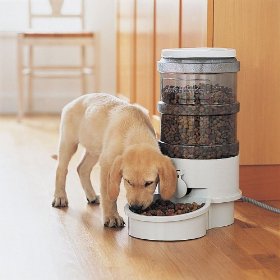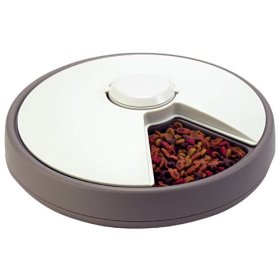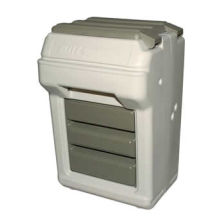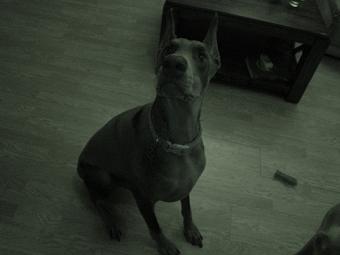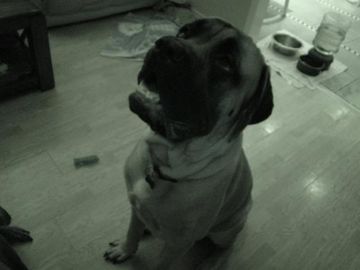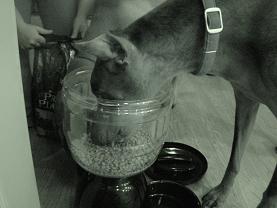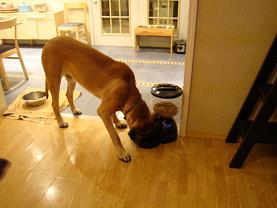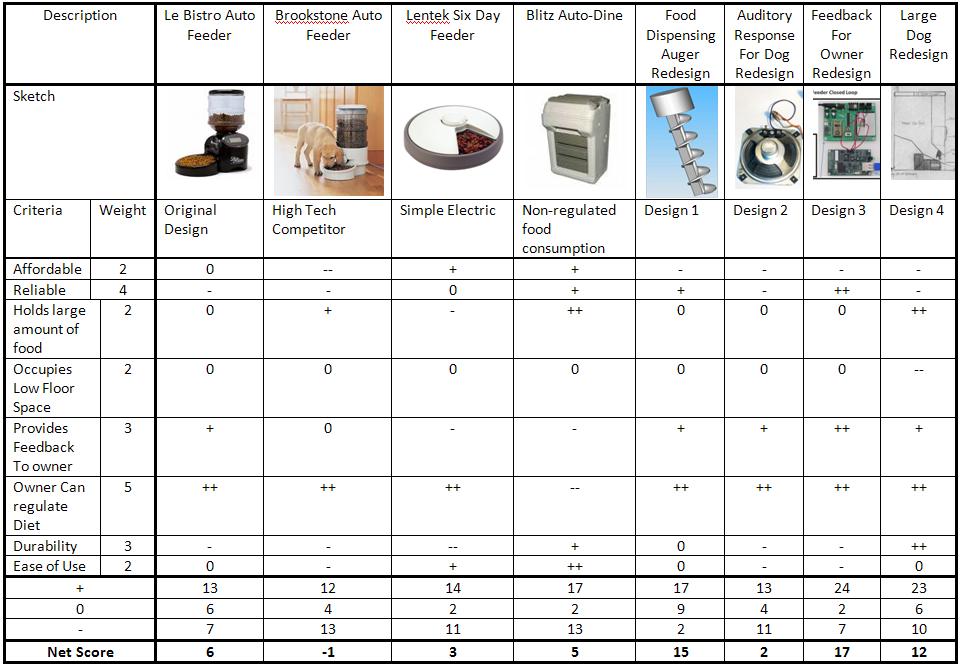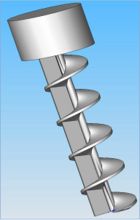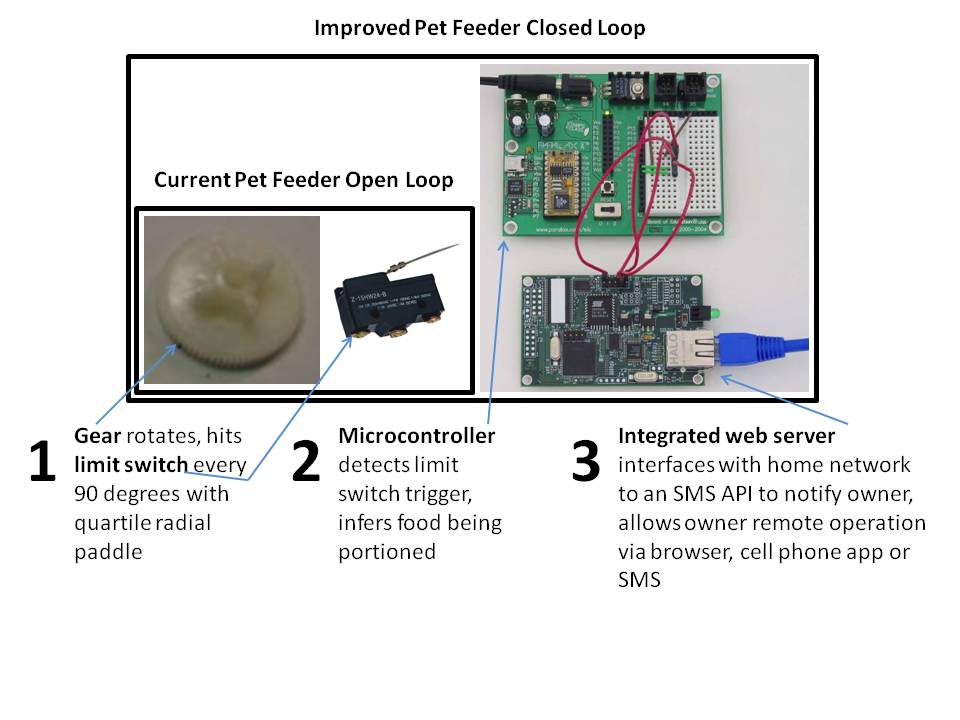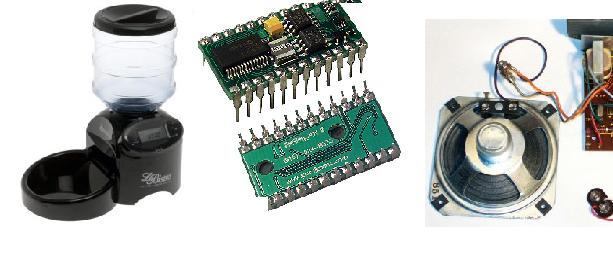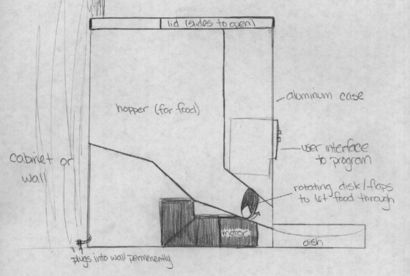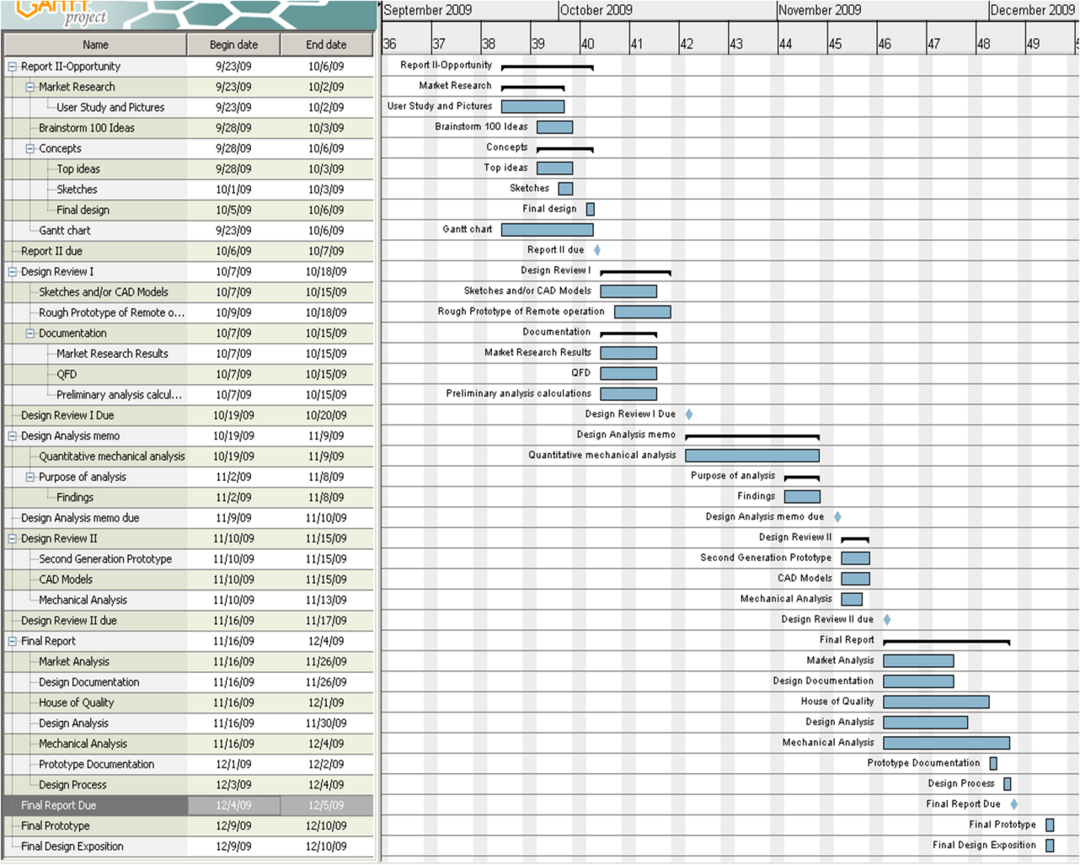Automatic pet feeder redesign
From DDL Wiki
Contents |
Executive Summary
The space of automatic pet feeders comes in two varieties. There is an automatic portion control device in which the owner prescribes the amount of food and then there is the variety that ensures that there is a constant amount of food in the feeding cavity at any time. The PetMate LeBistro Portion Control Automatic Pet Feeder is of the former type.
Our market research concluded that there are a variety of competing products that were essentially the same while some provided the ability to feed the animal for longer durations depending on the size of the storage unit.
Our user study suggested that the PetMate pet feeder is problematic for large dogs. Large dogs are aggressive with the product and can induce mechanical failure through normal operation. Additionally, the observation of pets using the product interacting with their owners brought up the issue of how this product, which is designed to operate remotely, doesn't allow one of its major stakeholders - the owner - to do anything remotely or be aware of the pet being fed for a peace-of-mind.
We have drafted several changes to the product to improve it by either reducing failure or enhancing it with greater functionality. We focused on the areas of feeding mechanism redesign because it previously allowed food to be fed intermittently, and we focused on the owner's experience operating the device by creating a solution for remote operation and notification.
Market Research
Below is a list of the basic types of competitors to our product. Their are 3 types, a high tech model, a cheaper simple model, and a non regulated portion model. Each model's specific features are explained, and some important user criticism and compliments are also included in the Customer Reviews portion. Each product has its selling points, but they all come with some downsides that our design team will take into consideration when we move forward with our prototype.
Brookstone Auto Feeder
Special Features<ref name="Brookstone_Product_Details">http://www.brookstone.com/Programmable-Automatic-Dog-Feeders.html?bkeid=compare|mercent|googlebase|search&mr:trackingCode=0DA45775-E985-DE11-9973-0019B9C2BEFD&mr:referralID=NA</ref>
- Price: $129.95
- 20lb capacity for large, but available in different size
- Programmable digital timer, allows for up to 8 meals per day
- AC adapter included, power cord has protective sheathing to prevent pets from chewing
- Battery backup
Customer Reviews
- 3.9/5 Stars on Brookstone<ref name="Lentek_Rating">http://www.brookstone.com/Programmable-Automatic-Dog-Feeders.html?bkeid=compare|mercent|googlebase|search&mr:trackingCode=0DA45775-E985-DE11-9973-0019B9C2BEFD&mr:referralID=NA</ref>
- Attractive design
- Able to feed 7 cats
- Difficult to program
- Pet can get extra food by sticking their paw up the food shoot
- Food amount unpredictable
- Works better with large amounts of food
Lentek Automatic Six Day Feeder
Special Features<ref name="Lentek_Product_Details">http://www.walmart.com/catalog/product.do?product_id=5969455&sourceid=1500000000000003260550&ci_src=14110944&ci_sku=5969455#ProductDetail</ref>
- Price: $39.84
- 6 separate, 2/3 cup food trays
- Can dispense wet food
- Serves up to six meals over six days
- Timer set on 6,12, or 24 hour intervals
Customer Reviews
- 3.5/5 Stars on Amazon<ref name="Lentek_Rating">http://www.amazon.com/Lentek-6-Day-Automatic-Pet-Dish/product-reviews/B00006JHRE/ref=dp_top_cm_cr_acr_txt?ie=UTF8&showViewpoints=1</ref>
- Loud motor
- Battery doesn't last very long
- Easily broken
- Trays are small if trying to feed a large dog
- Refill food often
Blitz® Auto-Dine 25 Dog Feeder
Special Features<ref name="Blitz_Product_Details">http://www.acehardware.com/product/index.jsp?productId=1288930&CAWELAID=112344059</ref>
- Price: $34.99
- 25lb. capacity
- Can be permanently mounted
- Water proof lid, can be used indoor or out
Customer Reviews
- 4.5/5 Stars on Amazon<ref name="Blitz_Rating">http://www.amazon.com/Bergan-Aut-O-Dine-25-Colors-Vary/product-reviews/B000BQSKS2/ref=cm_cr_dp_all_summary?ie=UTF8&showViewpoints=1&sortBy=bySubmissionDateDescending</ref>
- Dogs regulate own food consumption
- Dogs have to push door open to get food
User Study
Two human users (Allison Klee and Justin Lervin) and two dogs (Sly and Rigby) were studied using the original LeBistro dog feeder.
The Dogs:
Filling the Hopper
Filling the feeder was a challenge. Both dogs jumped and barked at the owner as they filling the PetMate feeding hopper. Sly actually got his head into the hopper and started eating right out of the tank before the owner could get the lid on. The dogs were noisy and pushy and got canine saliva on the owner and the automatic feeder. The food was difficult to pour into the small hopper and the feeder itself slid around the tiled floor while the food was pouring in.
Sly
The Before:
Sly ate out of a metal bowl on the floor next to a PetMate automatic water bowl. His shoulder height allowed him to reach his food bowl and water dish with what appeared to be only slight discomfort and both receptacles were large to accommodate his head and muzzle. The food dish was filled by hand once a day with two scoops of dry dog food.
PetMate Trials:
Sly was very cautious around the new feeder. The noise of the feeder dropping food scared him a little and he would not go near the feeder until Allison, his owner, went to the feeder and talked encouragingly to coax him to the food. Once he learned that the feeder was not an attacker Sly calmed down and ate right out of the bowl as soon as the food was dropped. After a few rotations of the feeder, it was programmed to drop food at a randomly picked time in the next hour, which ended up being 20 minutes. Sly was left alone and not encouraged to go to the feeder or stay in the room. As soon as the food dropped into the bowl Sly was eating it again, but he would dart away if the feeder made any noise.
Sly also interfered heavily with filling up the feeder and would push the hopper with his nose until it nearly fell over.
The solution proposed by the owner/human user was to make the hopper very large so that filling it up was a rare occurrence and could be done when it was NOT feeding time.
Rigby
The Before:
Rigby had a custom-made setup from Justin consisting of a wooden table with metal bowls sitting in cut-out holes. The food and water dishes were the same type and the table allowed Rigby to comfortably reach his food without straining his head or shoulders. Rigby's shoulder height makes it impossible for him to reach the ground without bending his front legs and crouching painfully. Rigby was fed six scoops of food, once a day.
PetMate Trials:
Rigby would absolutely not go near the feeder unless his owner was next to it and it was not running. If the feeder dropped food, Rigby would run into the next room. It took about an hour for Rigby to start eating out of the food dish on the feeder and even then any sudden movement would send him running. He once got so frightened that he knocked over the entire feeder and then ran sheepishly away. This may all be caused by the fact that he is a young dog [only a year old] and very large. His head did not fit well into the feeding dish. The tiny portions that the feeder provides mean that it has to turn for almost a full minute to give Rigby enough food for a meal. Rigby also pushes the feeder around the kitchen floor because he is much too strong and large to eat daintily out of a small feeder.
As you can see from the photo, Rigby is obviously too large to eat from this feeder. His head can hardly reach the ground without painfully stretching or bending [which is bad for large dogs to do on a regular basis]. The proposed solution is to have the dog feeder on a raised platform so that the larger dogs won't be strained. This could be removed to allow smaller dogs to eat as well.
User Interview
The human users had a few needs they requested be met
- hold enough food both dogs for three days with no need to refill the hopper
- be heavy enough to not move or have it be attached to something
- make the appliance sturdier so the dogs won't bend the plastic/break it if they knock it over
- create a redesigned appliance that could be meant for everyday use
User Scenario
A pet owner, named Laurren Watch, owns two dogs and lives in a large two story house. She has one roommate who enjoys the dogs' company, however this roommate does not have ownership over the dogs, and therefore he/she rarely takes care of the dogs. Laurren owns two battery powered automatic pet feeders, one for each dog, because she leaves town for business trips but wants to keep her dogs on strict diets. One of the dogs is a large German Shepherd, and the other dog is a small Chihuahua.
The pet feeder is programmed to dispense meals of different sizes, three meals per day.
Laurren leaves for one week on a business trip, and she sets the meal sizes and meal times. This is due to the fact that her roommate does not know how much to feed the dog, or at what times. Laurren believes that her roommate would forget to feed the dog or would leave the house to complete daily tasks, without filling the bowl.
This is a plausible situation based on our research with dog owners. Potential problems that could occur include:
- Laurren is worried that the feeder malfunctions, so she asks her roommate to check the feeder. The roommate could be confused by the three button interface, as well as by the manual feed function (Hold one of the buttons down for several seconds. The button that you need to hold is not labeled as the "manual feed" button).
Solution: change the interface.
- If Laurren asks her roommate to check the feeder, he/she would still not know whether food came out. The bowl could be empty since the dog ate all of it, or the feeder may have malfunctioned, and no food came out.
Solution: Add a feedback system to notify the owner of the pets.
- If the roommate is gone or busy, the large dog could knock one or both of the pet feeders over. User studies have shown that large dogs are willing to push the feeder. In this case the lid could become loose and food would be spread out on the ground. According to market research, many feeders hold at least several days worth of food. This is a profuse amount of food to provide to a pet, given that the pet knocks the hopper, and lid, off and food spills out.
Solution: Prevent feeder from falling over, or being top heavy.
- The feeder has been shown to provide inconsistent meal sizes during user studies. Since Laurren is concerned about the diet of her dogs, providing too little or too much food would be undesirable.
Solution: Add a feedback system to notify the owner of the pets.
- In this scenario Laurren may become worried and call the roommate, to have him/her check the dogs and feeders. Given the roommate's ignorance towards the dogs' diets, Laurren would look for an alternative to contacting the roommate. This is how the closed feedback system would provide an improvement.
Solution: A text message could be sent to Laurren, wherever she is, notifying her of meals recently provided. To close the system for the pet, the feeder could also provide audio recordings of the owner, so that the dog may recognize the owner's voice during feeding time.
Design and Competitor Comparison
Pugh Chart
Design Recommendation
This pugh Chart shows that our concepts for redesign directly address our top stakeholder needs and gives them a much higher score. The Net Score from the Pugh Chart identifies Design 3 as our design. This design is the best because it addresses the important need of reliability. If the owner is alerted every time their pet has been fed, it provides a peace of mind for the owner that none of the other designs can match. In the feedback for owner design issues are going to be affordability and ease of use, if these issues can be properly addressed it will be an effective design. The next best score comes from the Auger Redesign, which offers significant improvements in reliability because it is improving the most unreliable part, the feeding mechanism. We believe that an effective auger design will increase the meal size consistency.
Product Improvements
Below a discussion of the proposed improvements follows. Areas for improvement are in the feeding mechanism, and the user experience of operating the pet feeder.
Feeding Mechanism Redesign
The original rotating fin design was susceptible to food becoming stuck before reaching the bowl at the bottom. This design would be replaced by one relying on a horizontally oriented auger. The auger is similar in design to a screw, with threads that follow a helical shape, and the helical axis is the axis along the screw's length. The auger differs in that, compared to the properties of a screw<ref name="screw properties">http://www.buyblueprint.com/images/articles/48/122.jpg</ref>, the auger has a larger thread angle and pitch.
Rotation about the axis allows for translation of material along the axis <ref name="archimedes pump">http://commons.wikimedia.org/wiki/Category:Archimedes'_screws</ref>. There would be a chamber that the auger is held within, and the food would enter from a hole in the chamber, located above the auger. The food would only have access to the auger on one end, and as the auger rotates, food would be transferred to the opposite end, without interference from the other pellets of food. Once the food reaches the other end, there will be an opening at the bottom to drop the food into the bowl.
To maintain the feeder's ability to control portions, there will be compartments within the helical section of the auger. These will allow food within the auger to be kept in known portions, and a limit switch will be used to notify the motor when to run and stop. To trip the limit switch we will use a gear design similar to the current gear on the motor, with protrusions that contact the limit switch.
Owner Feedback Improvment: Remote operation and notification
To assume the status quo on the domain of pet feeders as a sufficient solution to the problem of feeding a pet when the owner is not present is something this design group does not do. If one considers the existential problem, and forgets about the specific implementation, product improvements organically arise from this exercise. Consider the fact that for a machine that operates remotely, it must be programmed locally. A machine that operates remotely should be accessible remotely since it is the remote operation that is the characteristic nature of the machine. Consider the fact that for such a delicate matter as ensuring that a pet is fed correctly, there is no peace-of-mind that the machine is operating. The owner is left to analyze the state of the animal as a feedback process for gauging the machines operation. While this may be sufficient in the non extreme case of daily departure, it is hardly optimal for the extended duration (1 week +) which this machine is ideally suited to do.
This discussion motivates two improvements in the area of feedback and interface.
1) Remote operation of the machine to modify feeding cycles and manually override prescribed feeding regimen
2) Notification system to inform owner that the pet was fed; (quantity, time, duration)
A diagram below shows how an embedded system solves both of these problems.
Auditory Pet Feedback Redesign
The original design of the pet feeder simply dispensed the food at the serving time. If a pet is not very observant or if the owner is trying to train it this could cause a problem. So this redesign involved adding a voice recording that not only alerts the pet that the food is being dispensed but also can tell them to sit and wait until the food is finished being served to eat. This allows a working individual to not interrupt the training of the pet just because they are not present. This could also comfort the pet when the owner is away for long periods of time.
The image above shows the basic essentials to complete this redesign. First on the left is the base pet feeder. In the middle is a picture of a parallax Basic Stamp 2 Microcontroller<ref name="microcontrollerpet_pic">http://media.digikey.com/photos/Parallax%20Photos/BS2-IC.jpg</ref>, and on the right is a picture of a basic speaker.<ref name="speaker_pic">http://transistorhistory.50webs.com/knight766guts.jpg</ref> This design simply integrates the micro-controller with the speaker and the original pet feeder as well as a voice recorder. Once connected the system allows the user to record and play sounds for the pet.
Industrial Feeder
The observations from the user study all point to a major problem with larger dogs: they push and nudge at the feeder until it is across the room or has fallen over. The larger dogs cannot get their faces in the small bowl and they can't bend down easily to eat directly off the floor. The small dog feeder also distributes a tiny portion of food every rotation (1/4 of a cup) and when a large dog eats six cups of food in one sitting it is frustrating and awkward for the dog to wait until the feeder is finished to eat his food.
The main problems that the new design address are as follows:
- Light, movable dog feeder that slides across the floor --> Dog feeder that bolts to the side of a ground cabinet in the kitchen or becomes a unit part of the kitchen, like a stove or refrigerator
- Hopper too small to hold enough food for more than one day --> Industrial sized hopper will hold a bag of dog food and will feed two large dogs with no refills for a reasonable time
- Low rate of food production --> Larger food hole will allow more food to get through and will reduce the time that the dog needs to wait to finish his meal
- Feeder falling over and dog eating food from the top --> The top will be a sliding one for ease of opening and closing and the feeder will be bolted in place to ensure that it will not fall over
Action Plan
Team Roles
Jason Calaiaro -Team Leader, exec summary, feedback mechanism
Lauren Walch - user studies, documentation of pet use, industrial redesign
Gary Lee - Gantt chart, Auger dispensing design, User scenario
James Langhauser - Market research, Pugh Chart, Auditory feedback design
Appendix A: 100 Brainstorming Ideas
1. industrial all-metal appliance
2. ‘corkscrew’ food mover [auger]
3. horizontal disc with hole for food to go through as food portion-er
4. stiffer food flaps to not let food through
5. interface with user’s blackberry
6. make a noise when food drops to alert dog
7. release a smell when food drops to alert dog
8. low battery light on at all times, not just when it drops food
9. options for brightly colored models
10. stiffer food vestibule because it’s flimsy right now
11. make it permanently attached to the wall outlet
12. options to change out parts for different food sizes
13. changeable bowl for different dog or food sizes
14. “all terrain” feeder to use on carpet, tile, hardwood, etc
15. holder on wall to keep feeder in place
16. odor blocking spray released when feeding happens to mask smell
17. hook to put the food bag on so it’s always with the feeder
18. feedback for amount of food left
19. self-righting mechanism if knocked over
20. two or more dishes attached for multiple pets
21. cat+dog feeder together
22. multiple types of food in multi-partitioned hopper so can choose which type to feed
23. very heavy base [a brick!?] to keep feeder in place
24. suction base to hold feeder in place
25. bolted to plate in floor
26. recycle uneaten food back into hopper
27. vaccum hose to suck food from the store-bought bag into the feeder
28. legs to support it and keep it upright
29. adjustable height or on removable platforms for different dog heights
30. programmable from your PDA
31. use as dog training – dog has to do a trick to get food
32. dog face recognition
33. monogrammable/personalizable parts
34. motion senses dog approach and feeds a little snack of food
35. recordable voice memo of owner for dog
36. retractable dish so it doesn’t get tripped over or pushed away
37. make all the screws the same type
38. make it robust for everyday use, not just for vacations
39. dog collar could interface with feeder to give the correct portion for multiple-dog people
40. ability to make breakfast/lunch/dinner different portions
41. on wheels to move easier
42. has handles on top that retract for easy carrying
43. has a microcontroller for remote interface
44. has a microcontroller for notifaction
45. uses SMS protocol to notify owner pet was fed
46. integrate a scale for precise feedback of portion
47. has RFID tags to sense a dog being close
48. uses RRID tags to enable multiple dogs to use the same device
49. uses RFID tags to enable feeding sessions, taking the owner out of the feeding equation
50. uses speaker system to tell pet it's time to eat
51. uses voice activated control system for ease of operation
52. auger-like hopper for more accurate dispensing mechanism
53. stronger attachment between hopper and base to mitigate failure of loose hopper
54. permanent attachment between pet feeder and floor
55. permanent attachment between pet feeder and wall
56. use thicker plastic in feeding mechanism to reduce failure of intermittent operation
57. use illuminated panel so that it is programmable at night as well as day
58. INCLUDE AC adapter... it's an insult not to!
59. sell additional hopper sizes so that a larger one can be ordered for extended operation if need be
60. make the feeding height adjustable so that it isn't awkward for larger dogs
61. has interface to know when family is eating and feeds dog at the same time
62. video link so owner can see dog through feeder
63. can be folded up flat for easy storage when not in use
64. refrigeration capability to keep cold cat food for cat application
65. rack to hold pet brushes and grooming tools
66. shoots food in the air so dog can play and catch it
67. cast the entire thing out of aluminum to reduce cost
68. connect the feeder to a timer to open the door to let the dog outside to go to the bathroom
69. large funnel opening to make pouring in food easier
70. robotic Roomba-type feeder that will find the dog at feeding time to deliver food
71 Mounting screws to attach feeder to wall
72 Detachable weights to make the feeder less top heavy
73 Add clips to the bowl/feeder attachment, so the bowl cannot be detached by the pet
74 Have a log in the feeder that allows the owner to check how many meals were dispensed while the owner was away.
75 Allow owner to communicate to pet through the pet feeder using cell phone
76 Design the dispenser at the bottom to adapt to any size feeding bowl
77 Add door to prevent pets from reaching into the feeder and knocking food out
78 Have feeder play irritating sound if the cat reaches into the feeder
79 Use a feedback control system to assure consistency in meal size
80 Using feedback control system allow the user to select meal size by filling bowl to their liking(people may not know how much food by cups)
81 Include a water dispensing unit
82 Have a fountain or some sort of flowing water, pets(especially cats) like flowing water
83 Have some sort of locking mechanism on the bowl, so that the pet can't easily knock it off
84 Add a motion sensor that can record and send the owner a message if the pet is hovering around the bowl(hungry)
85 Add a second hopper, that can be filled with treats or different food and can be operated by a separate timer
86 Add more buttons so that the use is easier and more self explanatory
87 Make a feeder that only dispenses treats
88 Use a gate instead of a feeder mechanism
89 Make hopper air tight so that humidity or bugs can't affect the food
90 Create feeder that provides cats with moist food
91 Can opening mechanism in feeder for canned food
92 Larger base so that dogs cannot knock over the feeder
93 Add chute so that feeder can be kept on high ground and food can follow chute down to the floor where the bowl is
94 Add a screen that displays images to the pet when the food is dispensed
95 Add lock to the top of hopper so that it will not open if knocked down
96 Provide multiple size dishes with the product
97 Have feeder throw tennis ball so that dog can play with it when owner is away
98 Contact owner if the feeder is low on batteries
99 Have a scale under the bowl to identify weight of meals
100 Make it water proof, so it can be used outside
101 Have a separate feeder with a separate timer that can be adjusted from anywhere from daily to monthly to dispense pills/vitamins to dog
References
<references/>

